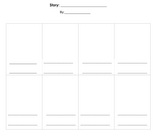
This is a visual that may used as a poster in the classroom to aid students in learning the parts of a computer.
- Subject:
- Computing Systems
- Material Type:
- Visual Media
- Author:
- Mary GREER
- Date Added:
- 06/01/2022


This is a visual that may used as a poster in the classroom to aid students in learning the parts of a computer.

This poster is a resource to remind students to keep personal information secret while online.

Essential Skill(s):Students should explain why they should not share personal information.Essential Question:What information can I share with others?

Students will be introduced to computer science words in conjunction with similar standards already taught in English SOLs. They will see how actions in a plot are similar to events in a code and how cause and effect is similar to events that trigger actions. Prewriting will take place as they create a plan and codes for an Ozobot maze.

Students will view a whole group video about responsibility and we will discuss being responsible with various things such as information, technology, and classroom items (the sensory items) We will also discuss taking turns and sharing, etc. Students will then be split into 5 groups and rotate through various sensory items. These items include a calm down corner, stretchy fidget strings, pop it squeeze balls, multi colored quiet fidget toys, and slow rising squishy balls. Throughout these rotations, the teacher will remind students of the responsible behaviors expected.

Lesson to support the Computer Science Standards of Learning

Students will love and enjoy this lesson based from the popular book, Snowmen at Night by Caralyn Buehner. Within this lesson, students will learn the importance of following algorithms in a particular order. They will also practice creating shapes while drawing their snowmen.

Students will sort colored animal counters into groups by color. Students will then color the correct blocks corresponding to how many colors of each animal they have in a set on a handout.

Students will love and enjoy this lesson based from the popular book, Bad Kitty by Nick Bruel. Within this lesson, students learn the concept of sequencing and storyboards. They will learn the importance of a storyboard by looking at the example in Bad Kitty. Students will show their understanding as they create their own storyboard about an animal of their choice.

This lesson will briefly introduce students to common computing systems they or their families use on a daily basis. The lesson focuses on responsible behaviors students can demonstrate to protect their information while using these computing systems. Students will learn to keep their information private, log out of shared devices, be respectful when communicating with others, and keep passwords private. All concepts are taught with the theme of becoming a technology superheros.

Through the use of a choose-your-own-adventure style read aloud, the teacher will guide students to create an algorithm for the story they are creating within the book. This lesson also serves as a basic introduction into the process behind computer programs, including games, when the user makes a decision.

Students will love and enjoy this lesson based from the popular book, The Tiny Seed By Eric Carle. Within this lesson, students learn the concept following an algorithm to complete a process. Students will learn about the way seeds can travel and grow as they listen to The Tiny Seed. They will also use this information to correctly organize the steps of their algorithm to plant a seed.

The class will collect data, make a graph (digital and paper), and interpret outcomes to answer questions.

This slideshow reinforces the idea of being nice when using a computer and what to do if someone sends something to you that makes you feel uncomfortable.

In this lesson students will understand that their name, home address, and their phone number is personal information. Students will also understand that they should not share this personal information with anyone online as well as strangers and why this is so important.

This slideshow is intended for Pre K and Kindergarten teachers for introducing students to technology vocabulary.The slides include a bried definition and images to support learning.

Co-authored with Kaitlin Read and Udaya DatlaCan you remember a time you've been sick? Why aren't you still sick? How did you get better?Join Udaya Sree Datla, a doctoral student in translational biology, medicine, and health at Virginia Tech, as she presents Infections, Germs, and Immune Cells. The accompanying lessons and resources provide students with an introduction to germs, the immune system, and the career path of an immunologist, all while emphasizing the importance of handwashing and incorporating a computer science twist. The second lesson capitalizes on an opportunity to integrate computer science by introducing students to the career path of computer programming and constructing a set of step-by-step instructions (algorithms) either independently or collaboratively to sequence the steps of handwashing. These resources are part of the Advancing Computer Science Education Grant to support the implementation of Virginia's Computer Science Standards of Learning in partnership with Floyd County Public Schools with additional support from Virginia Tech's Center for Communicating Science and the Institute for Creativity, Arts, and Technology.